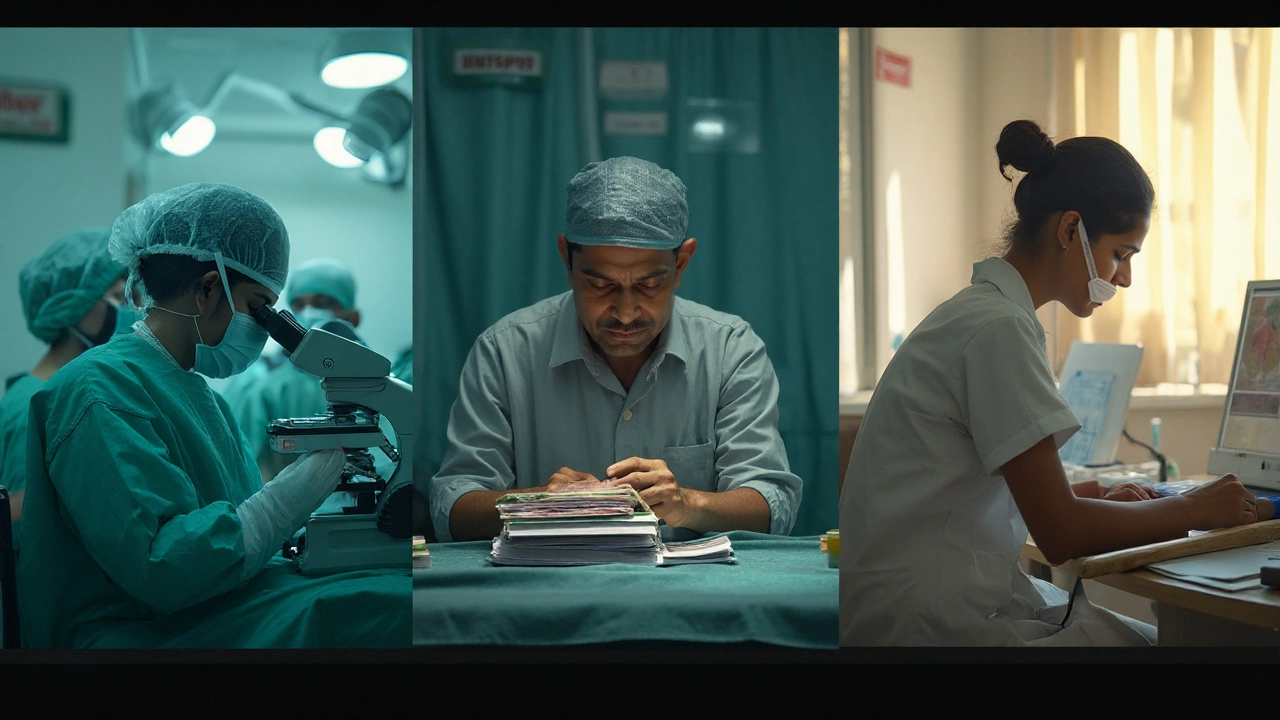If you’re here for a straight answer, here it is: in 2025, the doctors who almost always sit at the top of the pay charts are neurosurgeons and cardiothoracic (thoracic) surgeons-often followed by orthopedic surgeons and interventional subspecialists like interventional cardiology and interventional radiology. But pay lives on a sliding scale. Where you work, how you’re paid (RVUs vs. salary), call burden, and ownership can push a doctor’s income up or down by hundreds of thousands.
- TL;DR: Neurosurgery and thoracic surgery are the most lucrative, with total compensation commonly in the high six figures; top earners can cross seven figures.
- Orthopedics, plastic surgery, vascular surgery, interventional cardiology, and interventional radiology are the next tier.
- Setting matters: private practice with equity and heavy procedural work often pays more than purely salaried roles.
- Training is long (6-8+ years after med school), lifestyle can be intense, and risk is high. That’s why pay is high.
- Comp data varies by source; 2024-2025 ranges below come from Doximity, Medscape, and MGMA trends.
“Physicians and surgeons have some of the highest wages of all occupations.” - U.S. Bureau of Labor Statistics, Occupational Outlook Handbook
The highest paid doctor in 2025: who tops the list and how much they earn
First, what do we mean by highest paid? We’re talking total annual compensation: base salary, productivity bonuses (usually tied to RVUs), call stipends, quality bonuses, and any profit distribution or ownership draws. On that score, the top specialties in 2025 are still dominated by complex, high-risk procedural fields.
Short answer to “What is the highest paid doctor?”: neurosurgeons and thoracic/cardiothoracic surgeons, with many offers in the $650k-$900k+ range and top performers clearing seven figures, especially with ownership in ambulatory surgery centers (ASCs) or a large procedural volume. Orthopedic surgeons are close behind, and interventional subspecialists (cardiology, radiology) often land in similar territory.
Here’s a practical snapshot you can actually use when weighing options. These ranges reflect 2024-2025 U.S. data patterns reported by credible physician comp surveys (Doximity 2024 Physician Compensation Report, Medscape 2024 Physician Compensation Report, MGMA 2024 DataDive) and real-world offers I’ve seen candidates receive in the past year. Your mileage will vary by city, payer mix, call intensity, and ownership.
| Specialty (U.S.) | Typical Total Comp (2025) | Common Range (25th-75th) | Training After Med School | Notes |
|---|---|---|---|---|
| Neurosurgery | $750k-$1M+ | $650k-$950k | 7 yrs + 1-2 fellowship | High complexity and risk; heavy call; pay tied to case mix and volume. |
| Thoracic/Cardiothoracic Surgery | $700k-$950k | $650k-$900k | 6-8 yrs + fellowship | Cardiac and thoracic cases; programs with high surgical volume pay more. |
| Orthopedic Surgery | $600k-$850k | $550k-$800k | 5 yrs + subspecialty fellowship common | Spine, joints, sports can pay top tier; ASC ownership boosts comp. |
| Interventional Cardiology | $600k-$850k | $550k-$800k | 3 yrs IM + 3 yrs cards + 1-2 interventional | High-demand procedural skill set; call and STEMI coverage matter. |
| Interventional Radiology | $600k-$800k | $550k-$750k | 5 yrs DR/IR pathway + fellowship | Procedural radiology; growing case mix; call often required. |
| Plastic Surgery | $550k-$800k | $500k-$750k | 6 yrs integrated or 3+3 pathway | Mix of reconstructive and cosmetic; private-pay boosts upside. |
| Vascular Surgery | $525k-$725k | $500k-$700k | 5 yrs GS + 2 yrs vascular | Open + endovascular; call and on-site coverage influence pay. |
| Cardiology (non-interventional) | $500k-$650k | $475k-$600k | 3 yrs IM + 3 yrs cardiology | Imaging and EP subspecialties can earn more; call impacts bonuses. |
| Gastroenterology | $500k-$650k | $475k-$600k | 3 yrs IM + 2-3 yrs GI | High-volume endoscopy; ASC ownership is a major lever. |
| Urology | $500k-$650k | $480k-$620k | 5-6 yrs | Procedures + clinic; shortages in many regions drive pay up. |
| Otolaryngology (ENT) | $475k-$625k | $450k-$600k | 5 yrs | OR-based + clinic; facial plastics track can raise upside. |
| Diagnostic Radiology | $475k-$625k | $450k-$600k | 5 yrs | Tele and nights pay premiums; group ownership drives big jumps. |
| Dermatology | $450k-$650k | $420k-$600k | 4 yrs | Mohs and cosmetics add significant upside; low call burden. |
| Emergency Medicine | $325k-$450k | $300k-$425k | 3-4 yrs | Pay varies with market pressure and staffing models; shift-based. |
| Primary Care (IM/FM/Pediatrics) | $230k-$325k | $210k-$300k | 3 yrs | Value-based models, procedures, and leadership can raise pay. |
Two things are true at once: yes, those upper-tier surgical fields usually pay the most. And yes, you still need to love the day-to-day. The extra $100-200k loses its shine if you dread every call night.
Let me frame this with a rule of thumb I share with pre-meds and residents: pay tends to track three levers-scarcity of skill, procedural intensity, and risk/responsibility. If a specialty scores high on all three, it likely sits near the top of the comp charts. If it’s mainly cognitive, commoditized, or has a flooded job market, the pay flattens or dips.
One more reality check: location can swing offers by 20-40%. Rural hospitals pay more for hard-to-recruit roles. Big coastal cities pay less cash but may add lifestyle value or prestige. Private equity and hospital employment also change the math (we’ll get to that).

What drives pay: setting, location, RVUs, call, and ownership
Ever see two attendings in the same specialty earning very different numbers? Here’s why.
- Practice setting. Private practice often offers lower first-year base but higher long-term upside via productivity and equity. Hospital-employed jobs pay stable salaries with RVU bonuses and call stipends, but fewer ownership paths. Academic pay is lower, with prestige and research time as trade-offs.
- RVU math. Most productivity plans pay you for work relative value units (wRVUs). If your contract pays $60 per wRVU and you generate 12,000 wRVUs, that’s $720k before other bonuses. Interventional and surgical fields rack up RVUs quickly when volumes are strong.
- Call burden and shift differentials. 1:3 call versus 1:7 call changes your life and your comp. Nights, weekends, and holidays often add stipends or higher rates. STEMI call for interventional cardiology, for example, boosts both workload and pay.
- Ownership and ancillaries. Equity in a surgery center or imaging center can add six figures on top of clinical income. It’s also where you take on business risk. Read the buy-in details closely.
- Payer mix and procedures. A clinic heavy in Medicare/Medicaid will pay differently than one with strong commercial insurance and cash-pay services (think cosmetics or concierge models).
- Geography. Many high-paying offers cluster in the Midwest, South, and rural West. Coastal metros often have more applicants per job and lower starting bases.
- Market cycles. Emergency medicine and anesthesiology have seen supply swings. Radiology cycles too. Keep an eye on residency expansion and contract consolidations in your field.
Here’s a simple decision map I use with trainees who ask about “highest paid” versus “best fit.”
- Start with your clinical day dream. Do you want the OR? Procedures in a lab? Imaging suite? Clinic conversations? Your favorite day is your best compass.
- Check tolerance for call and emergencies. If your happy place is predictable daylight, think dermatology, radiology (day shifts), outpatient GI, or some concierge models.
- Look at training length. Can you handle 6-8 extra years and a heavy fellowship? Neurosurgery pays top dollar, but you’ll invest a decade post-med school.
- Run the RVU math on paper. Ask for wRVU rates, historical volumes, payor mix, and how often colleagues hit bonus tiers. If numbers aren’t shared, that’s a flag.
- Ask about ownership paths. Is there ASC or imaging equity? What’s the buy-in, distribution formula, and clawback if you leave?
- Weigh the human stuff. Partner expectations, culture, mentorship, and how often the team actually gets home for dinner. Money doesn’t fix a bad fit.
- Stress-test the exit plan. What if volumes drop or leadership changes? Can you pivot to a nearby market, or add a cash-pay service line?
If you’re comparing two offers, try this quick fairness sniff test:
- Normalize both offers to dollars per wRVU if possible.
- Put a value on call nights and weekends (e.g., add $1.5-3k per 24h call if unstipended, depending on specialty/acuity).
- Assign a conservative value to ownership distributions (e.g., 60-70% of the rosy projection).
- Factor benefits you actually use: 401(k) match, CME funds, relocation, tail coverage.
Common pitfalls I’ve watched new attendings stumble into:
- Chasing a headline number without understanding RVU floors, non-competes, or wRVU rates that are below market.
- Ignoring payer mix. A GI group with heavy commercial and an ASC can pay far more than a similar group with mostly government payers.
- Skipping lifestyle math. A $50k raise that costs you every other weekend isn’t a free win. Ask your future self (and your partner) what it’s worth.
- Not pricing risk. Ownership can be great. It can also tie up capital and add stress if volumes dip.
Last piece from the human side: pay tracks burnout in complicated ways. Proceduralists often earn more but carry heavier call and medico-legal risk. Medscape’s Burnout & Depression Report shows high burnout in emergency medicine, critical care, OB/GYN, and some surgical fields. Money helps, but schedule control and team culture matter more over a 30-year career.

FAQs, quick cheats, and next steps
Here are the questions I get every time someone asks, “Which doctor makes the most?” with no fluff, just the bits you can use.
Quick FAQs
- Who is the highest paid doctor in 2025? Typically neurosurgeons or thoracic/cardiothoracic surgeons. Orthopedic surgery and interventional subspecialties (cardiology, radiology) are close behind.
- Highest paying non-surgical specialties? Interventional cardiology, interventional radiology, diagnostic radiology, gastroenterology, and dermatology often lead. Electrophysiology within cardiology also pays very well.
- Fastest route to a high salary? There isn’t a true shortcut. Some fields with shorter training (dermatology, diagnostic radiology, ENT) can out-earn longer paths depending on market and practice model.
- Do academic jobs pay less? Usually, yes. You trade some pay for research, teaching, and prestige. Leadership roles and grants can narrow the gap.
- Private practice vs hospital-employed? Private practice can pay more long term with equity and productivity upside. Hospital jobs offer stability and better benefits early on.
- Does location really matter? A lot. Rural and smaller metros pay premiums in tough-to-recruit fields. Big coastal cities tend to pay less cash but offer density of opportunities for spouses and family.
- How do RVUs work? You get paid a rate per wRVU for the work you do. Higher wRVU volumes = higher pay. Ask for historical volumes and your rate per wRVU.
- What about burnout? High pay often comes with call and risk. Protect time off, insist on fair call ratios, and pick a team you like.
Cheat sheet: pay levers you can actually pull
- Negotiate wRVU rate. A $5 bump per wRVU can mean $60k+ per year at typical volumes.
- Lower your call load or get it paid. Swap unpaid call for stipends or fewer weekends.
- Add a procedure. One extra half-day of endoscopy or IR cases can move the needle more than adding clinic slots.
- Explore ownership. ASC or imaging equity can add six-figure distributions-if volumes and contracts are solid.
- Consider geography. One move to a high-need market can jump comp by 20-40%.
- Optimize schedule. High-yield blocks (OR/IR) and fewer low-RVU tasks raise income per hour worked.
Mini case snapshots
- Interventional cardiologist, mid-sized Midwest city: Base $600k + wRVU bonus (target $150k), STEMI call stipend $60k, total $750-850k at steady state.
- Orthopedic spine surgeon, private group with ASC: Base $550k year 1, partnership year 3; ASC distributions $150-300k when volumes mature; total seven-figure potential.
- Dermatologist, suburban practice: Base $420k + cosmetics + Mohs days; minimal call; total $500-650k with strong cash-pay demand.
- Radiologist (diagnostic), telerad nights: Premium per RVU, fewer meetings, high cash flow; lifestyle trade-off is nocturnal schedule.
Next steps (for different readers)
- Pre-med: Shadow three very different fields-one surgical, one procedural, one clinic-heavy. Journal the days, not the dollar signs. If the OR energizes you, keep that data point.
- MS1-MS2: Use summers to scrub in or sit in the reading room. Ask attendings what a “bad day” looks like. Can you tolerate the worst days of that field?
- MS3-MS4: Gather hard info on match rates and fellowship paths. Speak with chiefs about recent job offers and wRVU rates they’ve seen.
- Residents/Fellows: Request sample contracts early. Compare wRVU rates, call, and tail coverage. Ask about ownership track terms in writing.
- International doctors eyeing the U.S.: Research visa sponsorship, fellowship accreditation, and state licensure timelines. High-paying procedural fields are competitive; plan 12-24 months ahead.
One last note from the home front: even a great offer lands better when your family rhythm can support it. In my house, big decisions get a “weekend test”-can this schedule work through birthdays, school events, and the occasional emergency at 2 a.m.? If yes, the paycheck is a bonus, not the whole story.
Sources I trust for comp reality checks
- Doximity Physician Compensation Report (2024) - strong on specialty medians and regional spreads.
- Medscape Physician Compensation Report (2024) - great for specialty rankings and pay trends.
- MGMA DataDive (2024) - the gold standard for RVU rates and productivity benchmarks.
- U.S. Bureau of Labor Statistics - macro wage and employment outlook updates.
Use them together. One report can mislead in a niche market; three tell you the truth.
